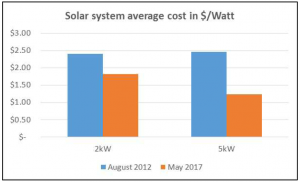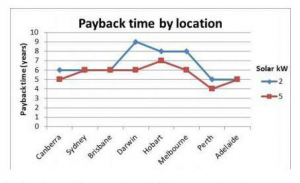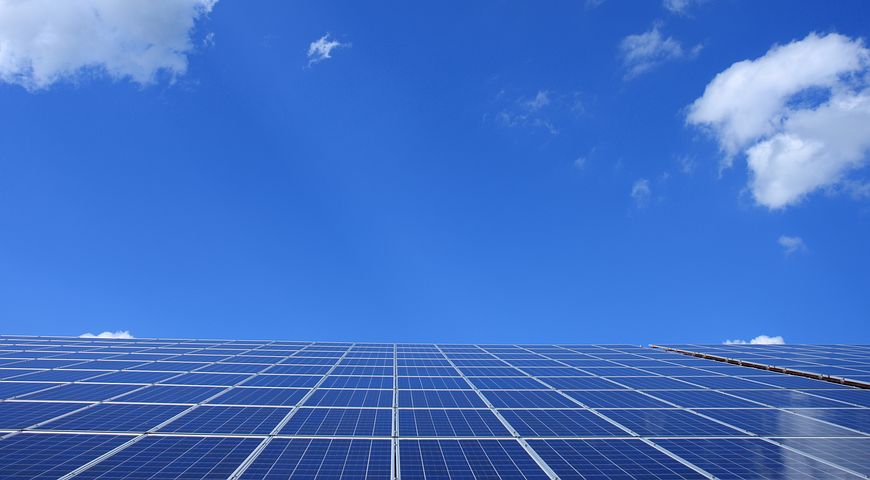The Australian energy market is always evolving, and the solar market is reflective of this. Increases to feed-in tariffs and decreases in the price of solar panels have provided a situation where larger systems are now tipped to save money and repay the investment in them over an equal, if not shorter, time than smaller systems.
Industry watchdog, the Alternative Technology Association (ATA) constantly reviews markets, prices and performance. Their findings, published in their discussion paper ‘Solar sizing: Bigger is Better’ supports this concept and explains the changes in detail.

Figure 1: Comparison of solar system costs 2kW vs 5Kw
Across Australia, the cost of solar installations has dropped over the last few years, with the cost of larger systems halving since August 2012, while the cost of panels for smaller systems has seen only a 25% reduction.
Along with this, the wholesale energy price has almost doubled over the last year and feed-in supply prices have followed the trend upward. Even though solar feed-in tariffs at 5 – 14 cents/kWh are less than in 2011 (when you could have received 60c/kWh) some states are increasing tariffs over the next few years to match the increases the wholesale rate, to the benefit of solar system owners.

Figure 2: Payback time by capital city for a 2kW and 5kW system
Put simply, the ATA found three areas of improvement in the solar market: (1) increases in feed-in tariffs; (2) decreases in production costs for larger systems; (3) increases in the efficiency of the installations as installers become accustomed to installing larger systems. A larger system can now be economic, even if it exports most of its power to the grid, and there were ‘no cases in which a 2kW system pays back quicker than a 5kW’, in most cases taking less than 10 years to achieve payback.
Larger systems are now more economic to install and capable of generating enough power to account for household use and still crank out extra energy to export to the grid. Household use at current grid price is around 20 – 35 cents/kWh, so using the larger system to supply as much of this energy as possible is the best way to utilise the installation. You only get 5 – 14 cents/kWh, depending on your contract, so your exports will make less of a contribution to lowering costs than household use, however, it will still reduce the overall repayment time for the system.
There are other ways to maximise your solar investment and recoup some of your money faster. There are passive ways to save, such as ensuring your house is well insulated, your windows sealed and well shaded in summer, and switching to LED lights. Improvements like these ensure that your home will use less power, leaving you more surplus energy to export for profit. Active ways to better utilise your solar include ‘load shifting’, by using your bigger, power hungry, electrical appliances such as washing machines, swimming pool pumps, or hot water service during the day when the sun is shining. You can incorporate relays into the solar system to automatically switch these items for you. Doing these things when the sun is at its peak can generate big savings, using the free energy to do your heavy work, minimising the use of highly priced grid electricity.
There are benefits of a larger system for our environment too. Larger systems offset more of the energy that would be produced by existing power generation technology. They are more economic to make and offset the energy used in their production in only one or two years.
Of course, other factors come into play when making the decision to install a solar system, and the choice of its size. Budget is a key factor. Even though there are good reasons to install a larger system, the overall cost is still higher than that of a smaller one and may be the single limiting factor. Rand apartment owners may have issues when dealing with landlords and owners corporations who may not be receptive to the idea of solar panels on a rented or shared roof. Some homeowners may just not have enough roof space or alignment for the installation of a larger system. Owners under older, higher, tariff agreements may find that installing new panels may breach those agreements and cost them money.
At Tandem Energy, we agree that now is the time to look at installing larger systems (around 5 kWh) regardless of your energy use, as opposed to smaller systems (2-3 kWh). We also recommend that you make improvements, such as those that we’ve mentioned, to your home first before purchasing a solar system. This will help maximise your returns and pay back your investment faster.

